Wilco Kelderman can see Tao Geoghegan Hart and Jai Hindley riding away, he’s losing time and there’s still the toughest section of the Passo Stelvio rising up ahead of him. For weeks he’d tracked race leader João Almeida and after a strong ride to Piancavallo the Dutchman looked set to inherit the race lead when the Portuguese rider discovered his limits in the high mountains, only now the Giro is slipping away from him.
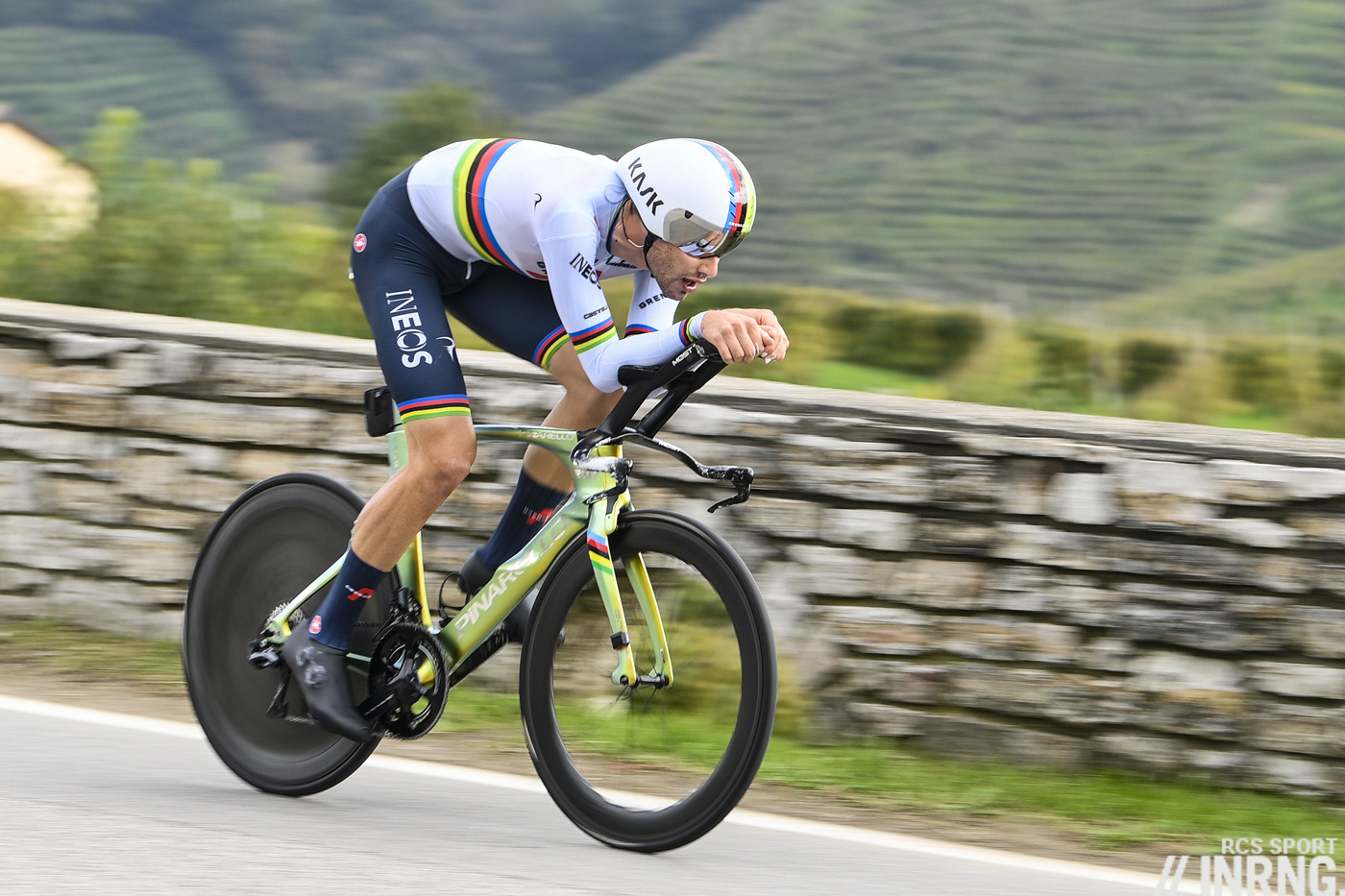
The race started in Palermo with a stage win by Filippo Ganna, his first of four stage wins. He brought certainty to the time trials, finishing well ahead of the second placed rider each time. He also took a stage from the breakaway, climbing up Montescuro in the dark, his path illuminated by the headlights of the RAI motorbike.

Arnaud Démare would prove to be the other certainty in the race, he was the best sprinter but not quite Ganna-esque as each time there was a sprint finish you never knew whether he could win. He’d win the points competition, correcting the bungled loss of the maglia ciclamino last year. His season over, he’s on 14 wins, and unless Sam Bennett or Pascal Ackermann win every sprint stage in the Vuelta and go away on breakaway days for more wins he finishes the season as the rider with the most wins in the pro peloton and 14’s not bad for a season abbreviated by a pandemic.
Were there any other certainties? Peter Sagan kept racking up placings, a new certainty but he traded that for the old with a masterful stage win Tortoreto Lido after riding the peloton and then the breakaway off his wheels. Diego Ulissi was perhaps one too, taking two stage wins to take his career total in the Giro to eight. Bad weather’s long been a theme in the Giro and so is a polemica and we got both, more on this in a moment.
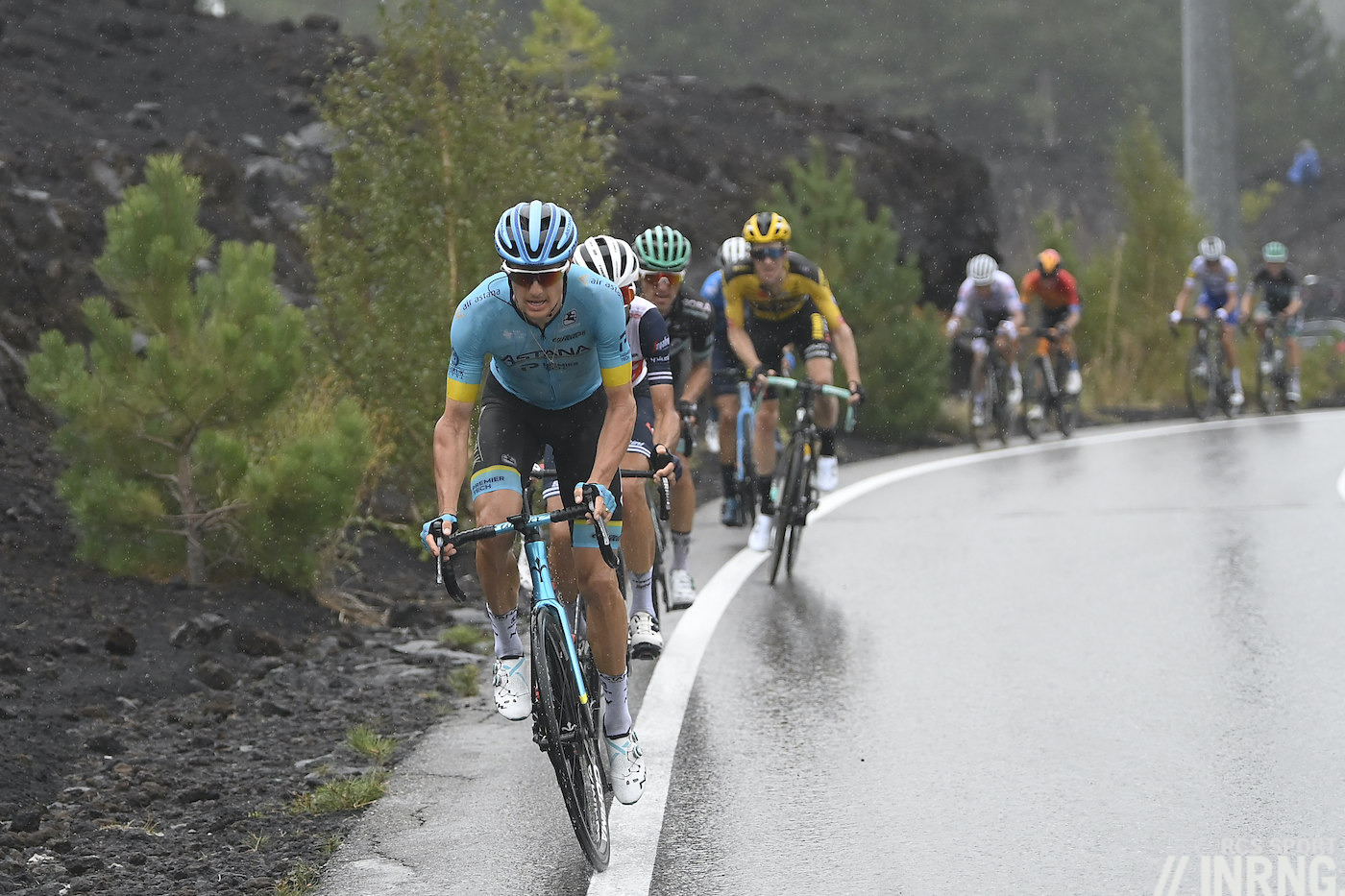
The stage to Etna saw the uncertainties begin. As the peloton rolled out of Enna they crossed some old flagstones, a few full bidons bounced loose, one of which rolled across the road like a miniature bowling ball until it got a struck Geraint Thomas’s wheels and he had no time to hop it, crashed and would lose 11 minutes that day before abandoning with a fractured hip. British hopes took another cold shower on the same day when Simon Yates looked out of sorts, losing four minutes on the slopes of Etna, he’d later leave the race positive for Covid-19. At the time Wilco Kelderman clipped away from the GC contenders and we got a battle behind between Jakob Fuglsang, Vincenzo Nibali, Domenico Pozzovivo and Steven Kruijswijk and in the absence of Thomas and Yates these looked like the big contenders. Etna was also where João Almeida’s pink parade started. Second in the opening time trial he was crucially also fractions of a second faster than the stage winner on Etna Jonathan Caicedo so when the two were tied for time atop the volcano it was Almeida who collected the maglia rosa and he’d wear it for 15 days.

Almeida had a long spell because the race didn’t go into the high mountains but he wasn’t passive, he kept harrying for bonus seconds on every mid-mountain stage going and extended his lead in the long time trial on Stage 14. When things went higher and longer though he was in trouble and the mini-summit finish in Roccaraso saw him lose time. It was a small climb and the end of a long day, but telling. It was where Tao Geoghegan Hart took 19 seconds on Jai Hindley thanks to a late attack but at the time “TGH” could ride away, with Lucas Hamilton, because nobody saw them as an immediate threat. Almeida lost time but so did Vincenzo Nibali. Also Ruben Guerreiro won the stage and took the mountains jersey which he’d eventually win after his only challenger Giovanni Visconti got injured and left the race.
The Valdobbiadene time trial didn’t shake up the general classification and it’s only with hindsight that the significance is apparently. Geoghegan Hart was 13th on the day but among the GC contenders only Almeida and Kelderman were ahead. Majka, Fuglsang, Nibali, Hindley, Pozzovivo were all behind. Geoghegan Hart just moved up one place on GC to 11th, with Hindley, Konrad, Masnada, Pozzovivo, Majka, Nibali, McNulty, Bilbao, Keldermann and Almedia ahead. Looking back you can see how these riders could be picked off but at the time it looked like Kelderman held the keys.
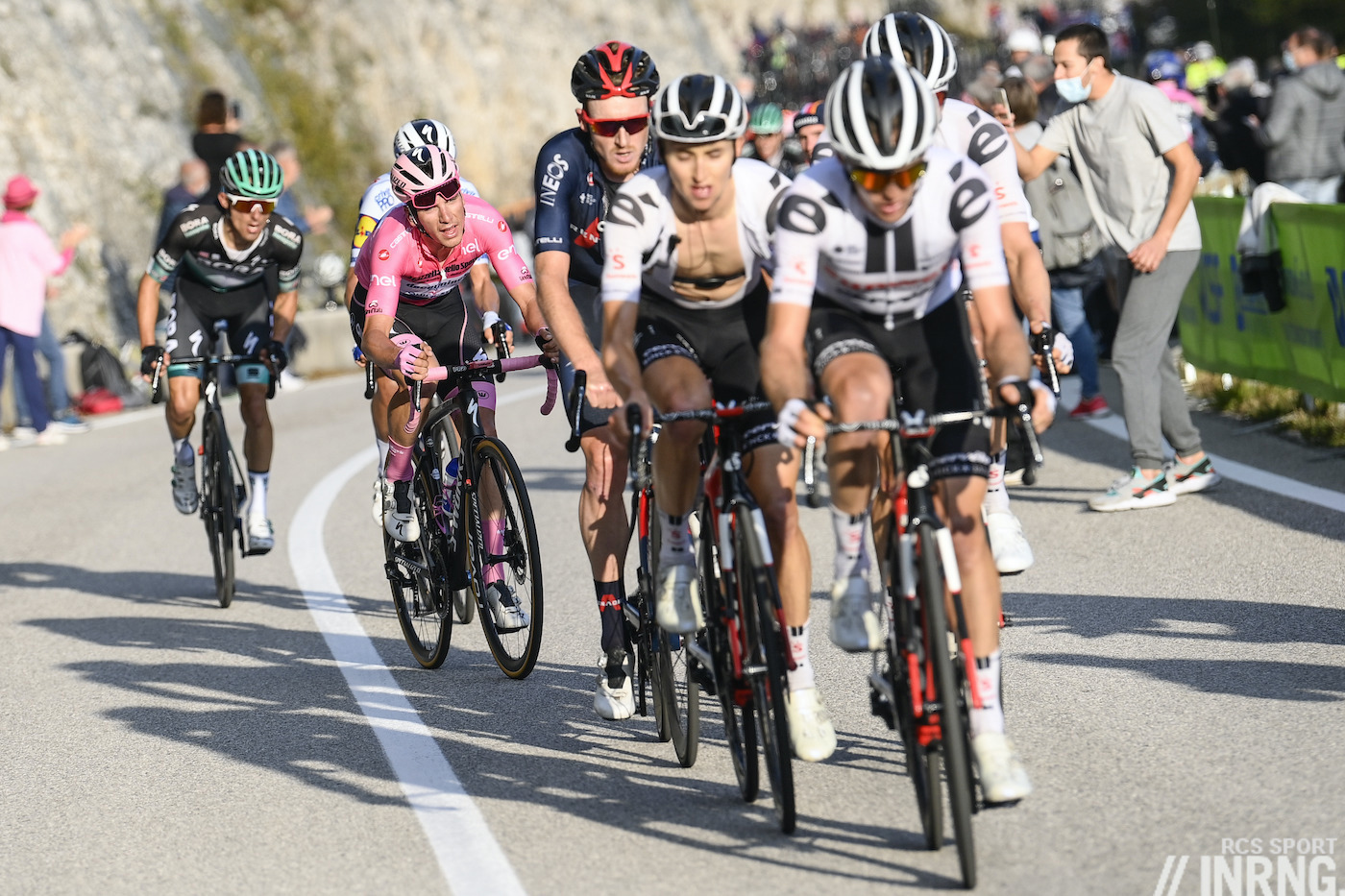
It was only on the road to Piancavallo for Stage 15 that Hindley and Geoghegan Hart emerged as GC contenders. 10th and 11th on GC respectively they leapt up to third and fourth overall with Almeida and Kelderman above them and the likes of Nibali, Majka and Fuglsang distanced. This was a crucial moment in the race, it wasn’t the moment the race was won but it did tell us who could win the Giro only then it looked like Wilco Kelderman again as he now had minutes on the rivals and the final time trial to suit.
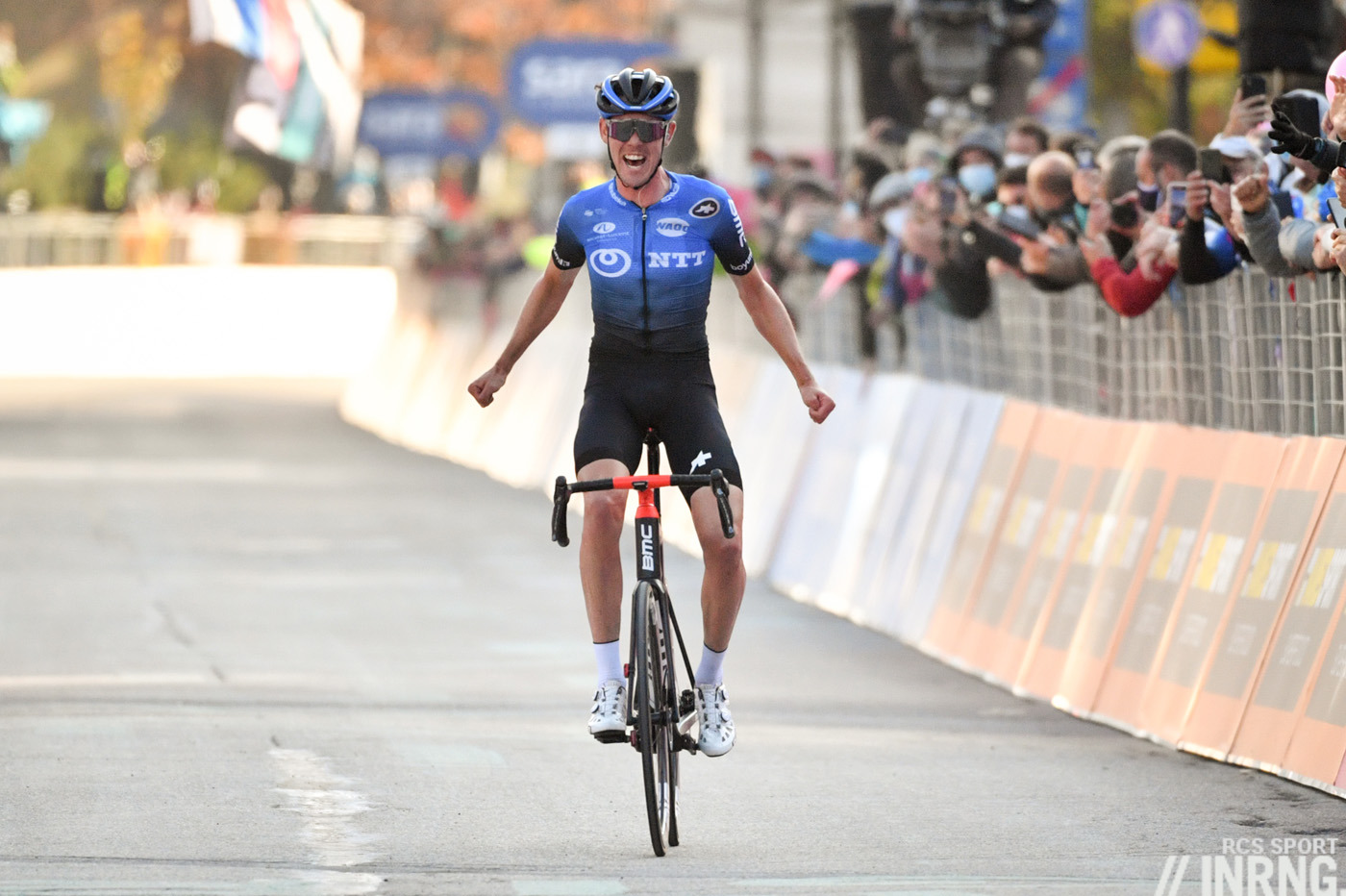
Ben O’Connor took a deserved stage win on the stage to Madonna di Campiglio and seemed to win a contract with Ag2r La Mondiale off the back of it, although the team have had their eyes on him. This was the Giro as the Vuelta, a late season careers fair this time heightened by the likely exit of NTT and the ending of the CCC team. Stage wins for Josef Czerny and Alex Dowsett were hopefully as precious but they’re the ones who converted the breakway into a win, plenty of others kept trying but couldn’t get the win, think of Victor Campenaerts or Joey Rosskopf. On the subject of breakaways Simon Pellaud proved great value to Androni, after his performances last year it was a surprise he “only” landed with this Italian team but rode the Giro and won the “flying sprint” competition. The stage itself didn’t deliver much though from the GC battle, an example of the Giro’s course design sometimes needing a twist or two.

The Stelvio featured on Stage 18. It’s a climb used sparingly, partly because it’s so difficult but also because at 2,758m above sea level it’s a gamble in May, the Giro has crested the pass 14 times but also had several cancellations. The poet Tennyson asked “What pleasure lives… in height and cold, the splendour of the hills?” and not having raced a bike he was yet to know the satisfaction of seeing your rivals several hairpins below you. This was a feeling Rohan Dennis must have enjoyed and for some time as he set a pace that only Hindley and Geoghegan Hart could follow and, crucially, both race leader Almeida and Kelderman could not. This was the start of Kelderman’s undoing, he looked to have the key to race but was dropped here and left to fend for himself while TGH had Dennis to tow him across to the next climb and this helped close a three minute gap on GC for the Londoner.
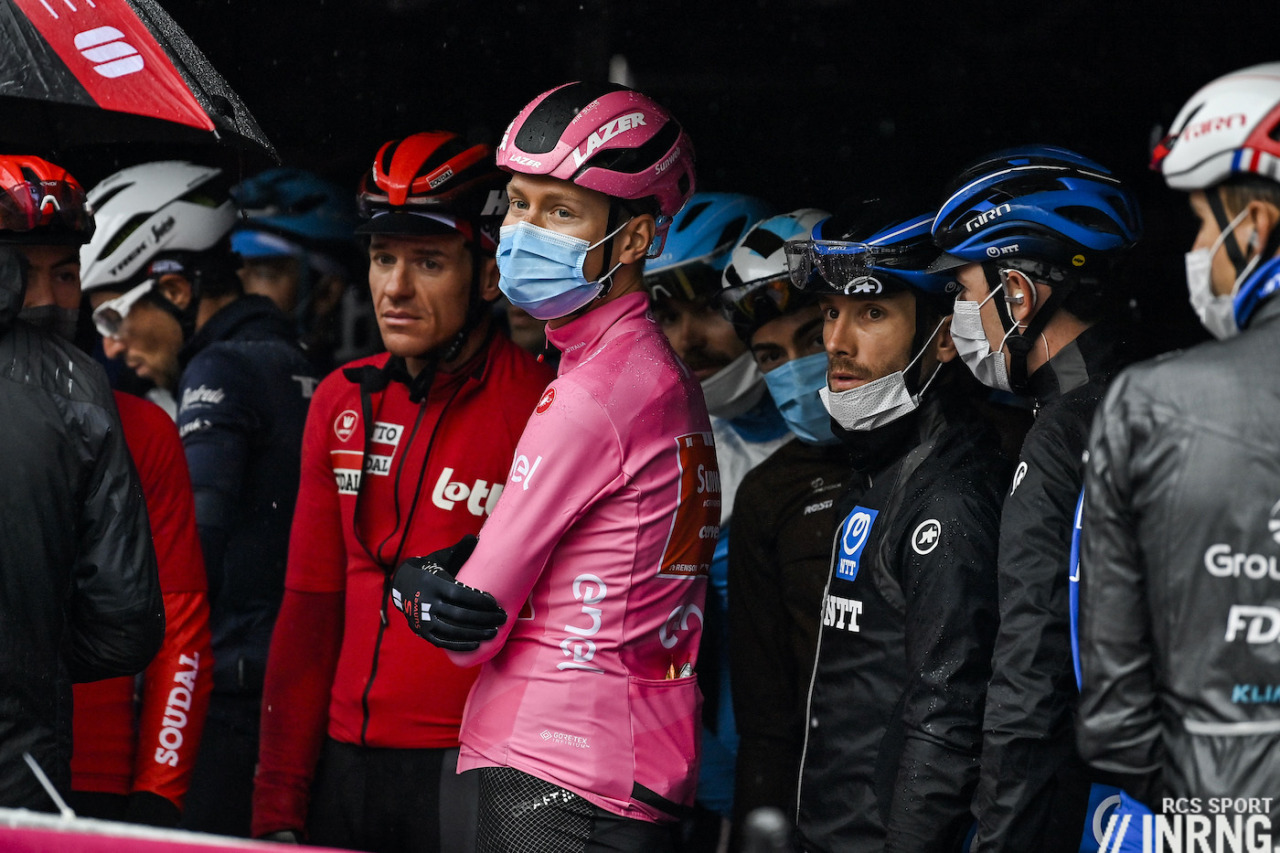
Stage 19 was notable for the rider protest. In sporting terms it was a footnote but in image and sports politics it was a cock-up . Like many disasters there’s an amalgamation of circumstances that provoke the incident and here it was the long stage of 250km deep in the third week and yes, everyone knew about this. But there were long transfers with riders leaving their hotels before dawn, plus it was raining. There’s also the CPA union, its leaders pressure from some riders to react faster and others outright contesting its legitimacy, it’s also struggling to communicate with riders, it uses chat apps but many riders are not part of the discussions. All this collided with the race organizers who suddenly had to restart the race with hours to go while respecting police and TV time tables and who have been under pressure for months after moving the Giro to October, and doubly-so when entire teams decided to quit the race mid-way, and one even went over their heads to ask the UCI to consider ending the race. As luck would have it was all on the day that media tycoon Urbano Cairo, the president of RCS, made his annual visit to the race so imagine how race director Mauro Vegni felt? You didn’t need to as even behind a mask and wearing a hood to shield him from the rain you could tell. Tempers flared and nobody could articulate why the riders had taken a stand, nor apologise to the locals who’d miss the race. The CPA union has since published an open letter which tries to set things out but the time to publish this was on the morning of the events. There are lessons to learn for all, a 250km stage late in the third week isn’t a great idea, nor is skipping a stage without a clear explanation and an apology to those waiting by the road who’d miss out. One side effect was that Matteo Spreafico’s positive test – for banned substances, not Covid-19 – was totally eclipsed when on another day it would have been a big issue and a deep embarrassment for the Vini Zabù team who rely on wildcards.

The “fight for pink” resumed in the roads around Sestriere and it was a repeat as Kelderman was cracked again by Rohan Dennis and Geoghegan Hart, again he could only watch as his team mate Hindley rode away on the back of the Ineos tandem. L’Equipe dubbed Dennis “the kingmaker” and you can see why, his work was invaluable in towing the riders clear, neither Geoghegan Hart nor Hindley had to attack the pack and on the descents and flat sections could count on continuous pace-setting. It set up a plot twist the organisers couldn’t have dreamed of as the pair went into the final time trial tied on time. In the final time trial Geoghegan Hart pulled out a lead from the start, seemingly able to muscle a bigger gear and won his first stage race.
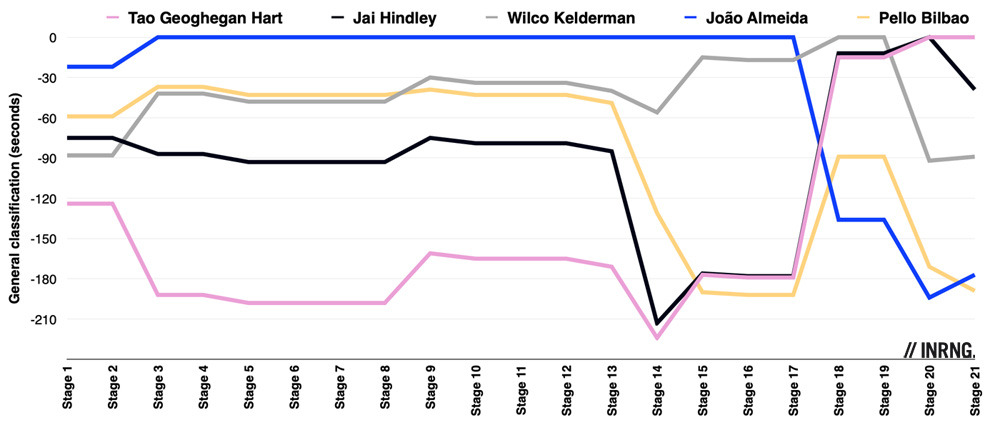
The chart above shows the GC standings with Almeida in the lead for 15 days. Wilco Kelderman made gains on Stage 9 to Roccaraso but look as Almeida takes time throughout the following week including the Stage 14 time trial. The pink and black lines of Geoghegan Hart and Hindley are a long way down and off the radar for the first two weeks. They make their ascension on Stage 15 to Piancavallo, the day Nibali, Fuglsang and others fell away. But it’s Stage 18 where the curves cross and Stage 20 where Kelderman collapses.

The Verdict
A race of surprises. We have to start with the viral pandemic and the calendar revision that moved the Giro to October. Were it in May then Geoghegan Hart wasn’t going to start. Perhaps he wasn’t even due to start in October either, as back in August he looked to be on Ineos’ Tour team only to crash hard in the Tour de l’Ain, so he went to the Giro instead. Thomas wasn’t supposed to start either, but did only to last a few days, while the virus took out Simon Yates and Steven Kruijswijk.
There are sometimes surprise winners of the one day classics, outsiders who get lucky on the day. It’s tempting to see the 2020 Giro in this light but a grand tour is long exercise in hierarchy, a three week Bayesian contest and Geoghegan Hart didn’t get in a lucky breakaway. Back in the 1956 Tour de France Roger Walkowiak became synonymous with a lucky breakaway propelling a modest rider to win the Tour, but Walkowiak was a better rider than that, he earned his win even if he did get in a breakaway that took 18 minutes. Geoghegan Hart didn’t win à la Walko, instead he rode away from all the other GC contenders, starting with the Valdobbiadene time trial and then in the Alps. A grand tour tends to settle questions, this one threw up plenty: what would Yates and Kruijswijk have done, although without them Geoghegan Hart and Hindley were also dropping Fuglsang, Majka and Nibali too. The questions go beyond the Giro, to see if Geoghegan Hart can lead Ineos into another grand tour and what would happen, to see what Almeida can do in week-long stage races, to pit Démare 2.0 up against more sprinters and is Ganna incontestably the best time triallist or just in the groove this autumn?
The tight finish brought suspense but only at the end, both this Giro and the Tour can go on a pedestal for suspense but for the finish, not their entirety. The general classification didn’t change much between Etna and Piancavallo but with no team in control this left space for plenty of good stage battles along the way, the breakaways often succeeded. As well as Geoghegan Hart, the Giro and Italy were the big winners, to reach Milan after everything was a triumph too.

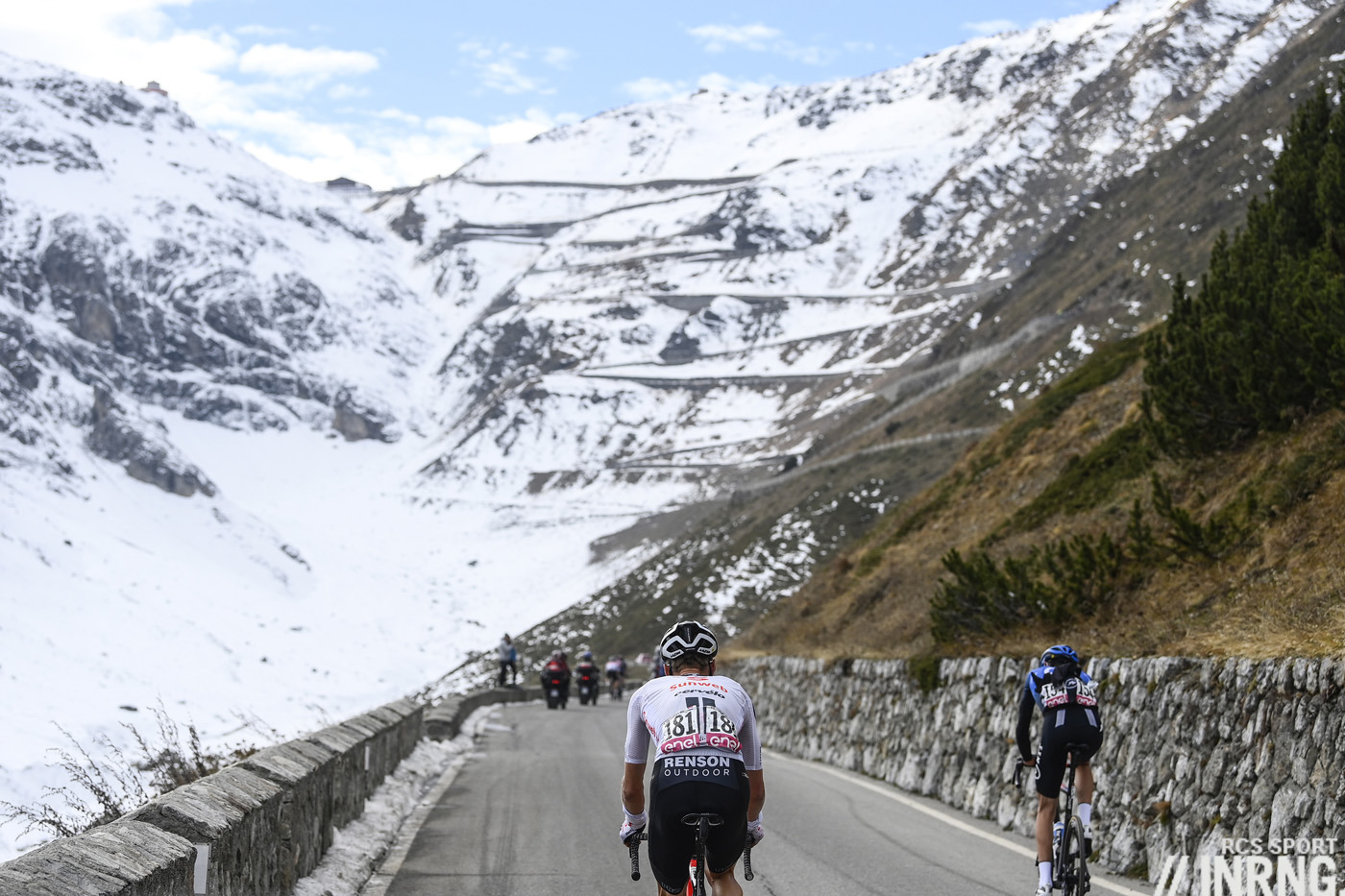
Well done to TGH and Ineos: they rode it perfectly.
Sunweb needed for Hindley to either attack TGH earlier on stages 18 and 20 in order to gain time before the ITT, or for Hindley to look after Kelderman on those two stages and hope Kelderman didn’t lose too much time to TGH.
As it is, they took a halfway house that almost guaranteed they wouldn’t win, and would get 2nd and 3rd.
WK looked shot so I think the best thing would have been to do what they did but to have Hindley attack TGH from a relatively long distance. Hindley might have dropped TGH and won the race or he might have lost time. But he could have lost over 2 minutes and still come 3rd.
Had they tried this they might have come 1st and 3rd, and at worst would have achieved the same result as they did.
Very much reminds me of the 2015 Tour de France where Movistar could have gone all out to attack a relatively weak-looking Froome and gain Quintana the win, but instead rode to conserve Valverde’s 3rd place on the GC, which he’d probably have got anyway (and, really, who cares).
No way of knowing if it would have worked out for Hindley (or Quintana), but I think he might well look back on this as his one shot at winning a grand tour, and he might well regret not taking the risk of sacrificing 2nd to maybe come 1st.
I don’t see TGH or Hindley winning a grand tour in the future: Hindley’s ITT is pretty weak, and look at TGH’s results prior to this Giro.
A very entertaining Giro when it came to individual stages, but the GC race was relatively uncontested until stage 18, and wasn’t contested much on stage 20 either.
I should have added: thanks for the daily previews, Inner Ring. The Vuelta is considerably less enjoyable without your many insights, which really shows the value of these pages.
I disagree. I think there is a bright future for both of them and I personally found watching them more exciting than Bernal. They dropped the biggest names in the peleton. TGH has a stage win to his name in a previous edition of Giro where he was a domestique. Hindley’s time trail was not great, but it is not a disaster, especially compared to other GC contenders/climbers.
I am interested to see what Ineos will do with another GT winner and their roster for TdF next year. My prediction is that they will try to promote homegrown rider and TGH will be favoured over Bernal.
I agree that Bernal was massively over-hyped after his TdF win. He beat a team mate, who by all accounts wasn’t that fit, and Kruijswijk, and was losing to Pinot until he dropped out. None of those are stellar names, and I wondered at the time why people were claiming he’d dominate GT racing for years to come. He’s a very big prospect, but still just that.
Not sure I agree that Bernal was ‘massively over-hyped’. Until this year he won pretty much everything put in front of him, including the biggest race in the world at a very young age.
“TGH has a stage win to his name in a previous edition of Giro” – what race are you thinking of there?
My mistake, you are right – he hasn’t won a stage in the previous edition.
Bernal has been diagnosed with scoliosis, which could open up opportunities for others in the team to replace him in leading the team at a GT in 2021. How near the front of the queue TGH will be, remains to be seen.
Bart. Ineos aren’t sentimental. The strongest rider will lead. TGH might edge it if they’re both considered equally strong. However given Bernal’s health issues it seems likely he’ll skip all of next seasons GTs to allow him to recover fully and therefore TGH should have a chance.
I think it’s a bit early to write off TGH’s chances in future GTs, J Evans. He seems to me a fairly rounded rider physiologically.
Possibly so, but usually promising riders have better early career results.
Take your point but it feels like some of the received wisdom about riders career trajectories is going out the window in the last season or two.
Like Roglic?……..
TGH has been a rider for a long time. Roglic was a ski jumper.
I understand that Tao Geoghegan Hart started competitive cycling relatively late, made significantly fast progress and racked up quite noteworthy results as a junior and U23.
Anyway, if you think it suffices to be skinny and fearless and to have an above average sense of body movement and position, you are badly mistaken. Those guys have muscles and nerves that fire impulses into those muscles that many road cyclists would sell their souls for.
And when it comes to developing the endurance required at elite level, most of it one is so to speak born with and a lot of how much of it one can get out and how fast one can achieve progress once one has begun systematic training depends on what one did as a child and in one’s early teens.
Like Froome?….
Yes, as I said, such riders are not the norm. Therefore we can name exceptions.
Great summary, thanks
I think the key point in the summary is not really mentioned enough: If GT hadn’t crashed out it would have been a totally different race, as he seemed quite far above all the others. Still, it is what it is, and it was a great result in the end
If GT hadn’t crashed out, and/or if Yates had been fit and not infected, then it’s easy to see how the race most likely would have played out.
Both teams brought very strong mountain trains. What Rohan Dennis did for TG, could have just as easily been done for GT, but with TG also providing an additional layer of support. They dropped all the other favorites – imagine if there was yet another lead-out in that train.
Michelton-Scott didn’t have quite as strong a train, but would almost certainly have been setting the race up for Yates to make late-climb attacks. That would have kept the pace extremely high in the first part of the long climbs, likely dropping Nibali, Fuglsang, etc., and potentially distancing some of Ineos’s leadout.
But ultimately, it would have been a race of the two trains. It would have been far less interesting, and far more predictable.
I wasn’t convinced by GT’s fitness this year. Looking back, I think TG wouldn’t have had the freedom to ride as he did, so if GT was present, Ineos wouldn’t have won the Vuelta. Instead, I think Wilco might have had a better shot, or perhaps Yates, assuming he could hold it together for the 3 weeks.
One of the most anticipated TMTRWW blogs! Thanks.
I know I should know better. But the grief Sunweb have been getting truly shocked me. Tao appeared to be gaining momentum and confidence after his stage win. A diligent fella, with great support. Très très formidable.
Much appreciated putting everything in to perspective🍀
Paddy, my problem with Sunweb is that they didn’t seem to act decisively. Drop Hindley back to Kelderman on the Stelvio or give Hindley the green light to attack TGH as the new team leader (if he had the legs of course). They did neither and essentially tried to hedge their bets. Of course, 2nd and 3rd is still a fantastic result and maybe they were happy not to take the risk that could have landed pink.
Re Sunweb and their tactics its worth remembering that it was they with Dumoulin that got Froomed at the 2018 Giro. Maybe they were just petrified of seeing another Skyneos rider ride away from them and take the win, and so they thought they’d better follow him. Which would be understandable, even if TGH isn’t Froome.
I echo everyone’s sentiments on our genial and generous host.
I find it hard to be too critical about Sunweb, unlike the histrionics in the Jumbo team car ere past.
But wouldn’t it be great to imagine a conversation of the day ahead like this one in a team car on the road –
https://www.youtube.com/watch?v=K8BPP4ASQWo
I’ll echo the sentiment expressed by others before me: the quality of the coverage on this blog is second to none. Thank you for your daily insights, well-informed stories, and talent for perspective.
The Giro had its moments, I think it was always going to miss a little bit of excitement due to the line-up, and it was a slow start (until stage 18, really, a pretty boring edition), but ended with a nice head-to-head. There will be regrets, I’m sure, from some teams and riders, but that only sweetens the future challenges.
PS (and I only add this part because of our host’s expressed interest for the Tour 1989): the Giro, and the inevitable last-day analogies with the LeMond/Fignon TT battle of ’89, got me to learn more about what transpired on the morning of.
Cyrille Guimard – Fignon’s loudmouth DS at Systeme U, turned loudmouth TV pundit at L’Equipe TV – reveals that Fignon had a groin injury at the end of the race that got really bad on that day, couldn’t sit on the bike properly and had to skip warm-up. Any other race he would have abandoned, but given what was at stake, Fignon was persuaded to stay on. Guimard blames the taboo around those injuries at the time (maybe still, considering how many cyclists suffer from perineum pain without uttering a word) for the lack of media interest in the story.
I’m not a big Guimard fan myself (he’s got his personality), but for someone that Fignon said “lacks any quality as a human being”, you could feel he was still emotional about his rider’s narrow miss, against his former protege, no less. An interesting moment, from the L’Equipe TV stage 21 pre-stage show, worth sharing… but isn’t yet uploaded on their replay section, thankyouverymuchl’Equipe >_<
The main image of Wilko Kelderman looking up at what is to come on the way to the Stelvio is a great cycling image, perfectly encapsulating the challenge. Difficult to know what he must have been thinking at the time as the group ahead rode away to leave him to fight on his own.
There is an argument that the “moment the race was won” was when the bidon took out Geraint Thomas before the race had really started but perhaps that is too trite.
The more years I watch the Giro the more I come to believe it is the best cycling race around. It does not represent the soul of Italy in the way the Tour does France, the scenery in France might be a bit better, the Giro certainly has less media hype and the yellow jersey certainly has more kudos than pink. However the Giro most times is a better race, it is more unpredictable whether because of the road surfaces, the route or the often wacky weather. It is difficult to image a rider coming from 3 minutes plus down to win the Tour, not so the Giro. Maybe it is down to the fields being not quite as (theoretically) strong which allows for more competition. No other race does polemica like the Giro, so much so the race director is keeping it going days after the race has finished.
Whilst the last few days were great racing this was not a great edition of the Giro. Nothing to match up to say Simon Yates’ victory on Gran Sasso, Tom Dumoulin’s adventures on his way to victory, Steven Kruijswijk’s disaster, Nairo Quintana riding away down the Stelvio whilst the rest of the race thought it was neutralised or Chris Froome’s ride for the ages. I doubt we will ever see 1st and 2nd going into a final day time trial tied ever again but the TT itself did not really have that much tension, nothing like the one at the Tour.
Tao Geoghegan Hart was a worthy winner, he grabbed the opportunity given to him ably assisted by a masterful team performance. The various sniffy comments about weak field, riders missing etc really are not worthy. He showed he was the best all round rider in the race, of course you need some luck to win a Grand Tour, there are always elephant traps just around the corner. Cliched maybe but not less true for that, the best riders make their own luck.
He seems a remarkable grounded individual but driven too, it is clear he enjoys riding his bike but also understands that it is a privilege to get paid (presumably a lot more now) for doing so. If recent reports are correct he could be in a better position for the future than some of the immediate post race commentary suggested. Egan Bernal looks to have a long term issue, Chris Froome is leaving, Geraint Thomas might now struggle to hit the heights again, is Adam Yates really a GT contender. It would be no surprise to see him back as Ineos’ leader at the next Giro.
As always thanks go to Inrng, the quality of the prose, linguistic ability and the understanding and insight into bike racing are top class .
‘the scenery in France might be a bit better’
Said only a Frenchman
Non! An Irishman living in Bavaria! I like Italy and go to Tuscany most years for summer holidays. However there is a greater variety of scenery in France and perhaps I have a preference for verdant greenery over some of the drier landscapes more common in Italy
I think the Vuelta has the best scenery, especially when they stay in the north, like they do now. And France is a bit nicer on average than Italy, because the ‘bad’ parts of northern France have that sort of epic grimness, whereas the ‘bad’ parts in southern Italy look like bad parts of the USA: wide empty roads with random positioned buildings in a dry landscape.
Does anyone know how much ISN are paying Froome and, more importantly, do they have anything written into the contract regarding his performance and/or recovery from his current injury?
They seem to do a fine line in paying good wages to riders past their peak, but surely this could be an absolute fortune paid on someone who is crocked?
Of course Froome might get back to his best, but it seems a hell of a risk for ISN.
Even if he gets back to 80% of his best he will still be a decent rider. Can maybe do a top 10 on GC or win a big stage. That’s prob what they’re betting on
How much would you pay for that?
That lead image is *chef’s kiss*
Thanks for the great coverage. Lots of online conjecture regarding Sunweb’s tactics in the final days that I find uninteresting. Given this weird year, I’m just so glad to have had some new names, dynamic racing and some organic racing drama.
Just re-read Roger Walkowiak’s obituary, on the same page you have a map of the 1956 Tour route; looks like the final stage from Montluçon to Paris was about 340Km! (No mention of a riders’ strike, must not have been raining).
Ouch, even today it’s over four hours by car or train… and few riders had salaries then either. Distance and adversity are pro cycling’s calling cards, beyond untelevised ultra events no other sport has three week races with daily contests that take 2-3 times as long as a marathon. It’s good and sometimes bad, a subject to explore over the off-season.
One of the main things I liked about this Giro, on top of the good close racing and great scenery, was that both TGH and Hindley, and Almeida, look good on a bike. I appreciate this is a strange thing to say and I don’t really know why its important to me but after years of watching the likes of Froome, Aru, Bardet and Dan Martin spin, gurn, swing and just generally ugly their way through Grand Tours it was nice to see riders who look well proportioned, coordinated and just right on a bike. You could probably say the same about Pogacar and particularly Roglic too who both look pretty well turned out. A decent year for the aesthetics in cycling.
I’m trying to get into the Vuelta but I’m just not feeling it. A bit like when you break up with a girl who you really liked and start seeing someone else just for the company. I usually struggle with the Vuelta but straight after a Giro it seems even worse.
The Vuelta’s interesting as no team can control it, we keep getting giant breakaways. If you’re hesitating, tune in this week as it’s got more summit finishes and the time trial, the third week is going to be more flat, certainly in terms of terrain but unless there are crosswinds, sports-wise too.
FWIW, I find this year’s Vuelta really fun to watch from the start, rare are the stages that end up sticking to the recipe.
Picking up on your aesthetic comments (with which I generally agree):
I was riding thru Washington DC the other day when I passed an apparition, or so it seemed – a rider (not too heavy nor lean) headed the other way, seated just so (not too hunched over, not too upright), pedaling just so (not too fast, not too slow), making good time (but not blazing) and not showing any strain, steady and solid but not ‘heavy’, looking as tho this kilometer would be no different from the previous 50 nor the next 150…like a riding style I’d not seen since the 70’s or so. It was uncanny, as if a wraith from another life had suddenly appeared in the 21st century just to ride a bicycle beautifully down the boulevard…
Probably on an E-bike 😉
+1 Re riders that just look “at one” with their machine
I’m a long time lurker. It was a great Giro made better by your truly great previews. Thank you.
I second that! Thank you!
Thanks to Mr Ring for another year of great coverage. There’s hope that next year will return us to the norm.
One thing I notice in the final time trial is the comradery between rivals. Compartment’s hat off to Ganna on the hot seat is really cute, he was also the first to congratulate Ganna at the finish; Hindley
fist bump TGH in the start house; even Guerreiro celebrating Tao’s win (they were team mates).
I think this only happens in cycling. As the riders really survive the Grand Tours together.
Love the auto-‘correct’ – I think ‘Compartment’ is going to stick. 😂
Thanks for the excellent coverage and this final perfect summary. It always amazes me how unexpected a grand tour GC contest can be, despite it being “a long exercise in hierarchy”. Even the warm-ups (Dauphine and Tirreno–Adriatico) can be surprisingly poor indicators of GC performance, as can one day or week-long races more generally – what factor is it that means Almeida/TGH/Hindley already seem more suited to 3-week racing than experienced riders like Fulgsang/Majka/D Martin?
Looking forward, it will be curious/exciting to see how many of the following under 30s will define grand tour racing in the next 5-10 years, and how many will struggle to reach the heights they’ve already hit: Pogacar, Evenepoel, Geoghagen Hart, Hindley, Carapaz, Bernal, Sivakov, Martinez, G Martin, Almeida, Mas, Soler, Buchmann, Vlasov, S and A Yates, as well as the guys that might be capable of contending for GC (Knox, Higuita, Carthy, Kuss, Haig, Masnada, McNulty, O’Connor, L Hamilton, Ciccone etc.) and those that may one day re-define their focus (van Aert?).
MVDP
I presume Sunweb think this mini-documentary shows them in a good light.
https://www.youtube.com/watch?v=QHTgOFJxecg
That’s a hard watch – strangely low energy throughout.
It’s a weird drama to see them repeatedly massively exceed expectations and progressively lose hope of something bigger at the same time.
on those clips I think it’s fair to say the DSs didn’t get it right mood-wise. The only way they could have made it any clearer they were sure JH was going to lose the jersey on the ITT would be just to abandon.
The difference in mood between this video and those when Tom Dumoulin won and also when he was blown away by Chris Froome are huge. Previously, even after the Froome stage, they are upbeat and focused, this was a team going places. Here this is a team that does not believe in itself or in its leader. The riders seem to be going through the motions, the DS trotting out tired cliches. There is no sign here that Wilko Kelderman ever really thought he could win and his treatment by the DS when he was struggling (but in the virtual pink jersey) after the Stelvio was embarrassingly bad (why show this to the world). Why would any rider want to stay with this team after watching this, there must be better teams to ride for. It rather explains the exodus of all the best riders, how long will Jai Hindley put up with riding in this atmosphere?
I wonder how it compares to the atmosphere in camp at the tour? They were equally successful at both, but at the tour you’d imagine they were bouncing off the walls with excitement.
Thanks for sharing this… It’s brave of Sunweb to put this up: it makes for a bleak 20 minutes. Baffling to think that they made it themselves, watched it back and still published it.
In the first segment (Kelderman in the hotel room getting an ‘inspiration session’ from the dead eyed DS)… it had me wondering if perhaps Sunweb were treating us to a cycling remake of ‘The Office’: sadly not.
Watching the Road Uphill I was really struck at how uninspiring the team talks were, and also perfunctory “you go, and you go. If he goes, you follow”.
Reality is a lot less glamorous and I imagine that living day-in-day out with each other, and after close to three weeks it can be hard to raise optimism and energy when everyone is pissy and tired, and bored of each other.
Living in hotels and tour buses for weeks on end is crap, no doubt about it, very little glamour and much boredom. However other teams (or at least the successful ones) do seem to have an espirit d’corps that is not evident here.
They’re an incomprehensible team. So good in the Tour, and yet made a hash of the Giro, and then you have the various unhappy riders leaving (Barguil, Dumoulin, Oomen, Kelderman…). They tell us they’re focusing on classics and stages, and then they sign Bardet…
strangely riveting.. Kelderman’s body language tells you he was a beaten man even before the Stelvio stage started… that DS tho…
Reinforces my theory that 95% of DS are rubbish
Which is better than the 100% armchair fantasy world DS herw…
Picking up on your aesthetic comments (with which I generally agree):
I was riding thru Washington DC the other day when I passed an apparition, or so it seemed – a rider (not too heavy nor lean) headed the other way, seated just so (not too hunched over, not too upright), pedaling just so (not too fast, not too slow), making good time (but not blazing) and not showing any strain, steady and solid but not ‘heavy’, looking as tho this kilometer would be no different from the previous 50 nor the next 150…a riding style I’d not seen since the 70’s or so. It was uncanny, as if a wraith from another life had suddenly appeared in the 21st century just to ride a bicycle beautifully down the boulevard for my benefit…
Sorry, meant that comment ^^^ for Richard S above…
An awful lot of assumptions that Thomas would have won. He got one grand tour right, and that after the two superior riders had done the Giro. Plus he has a history of not getting himself properly fit, since that Tour de France win.
Not sure that’s quite accurate. A recovering Thomas was best of the rest in the 2019 Tour, while he’s been taken out by Majka, a motorbike and now a water bottle while looking good in other grand tours. Compared to the top ten of this Giro (except Nibali) he has an excellent stage race record, was the best TTer and was seemingly in form (based on T-A and Worlds TT).
Agree that it can’t be assumed that he would have won, but you’ve made a lot of assumptions about the quality of Thomas’ record, right?
The good news is that the many-worlds interpretation of quantum mechanics allows for an uncountably infinite number of possible Giro outcomes. The bad news is that Thomas would still fail to finish in every single one of them.
Ha!
I suggest we let the good folks at FiveThirtyEight award the next grand tour by just extrapolating from online commentators judging and rating the palmares of the main contenders.
Let’s finally get rid of all that racing nonsense and just look at stats. Yummy yummy stats.
7 straight GTs with a first time winner. Anyone know when that last happened?
2010-12 if you remove Contador’s 2010 Tour and 2011 Giro. The streak was bookended by Basso’s last Giro and Contador’s 2nd Vuelta, and went: Schleck*, Nibali, Scarponi*, Evans, Froome*, Hesjedal, Wiggins.
If you don’t remove Contador’s 2010 and 2011 wins, the answer is 1965-67, between Anquetil’s last Tour and Gimondi’s first Giro: Wolfshohl, Adorni, Gimondi, Gabica, Motta, Aimar, Janssen
1956-58 saw 8 in a row, between Bobet’s last Tour and Gaul’s 2nd: Conterno, Gaul, Walkowiak, Loroño, Nencini, Anquetil, Stablinski, Baldini.
Great photo choice to illustrate the moment… thanks for bringing us along with you, it’s much appreciated.
Thanks INRG,
Readers any insights of how Brandon McNulty would have done with a bit more team help in the hills?
I think he must have come back to earth with a bump after his comments post the long time-trial along the lines of ‘oh I just have to hang with the front guys now and it’s looking good…’
Many Thanks for the recap and the coverage. Always a pleasure to read.
After Team INEOS lost the Tour with Bernal, it looked like the year could be a real disaster for the team and now that the season is drawing to a close, they have already won a Grand Tour and another victory may follow. Not bad. Brailsford looked very happy and unusually relaxed during the interviews at the finish. Perhaps an indication that the pressure on him was very high after the messed up tour?
As others have pointed out, the Sunweb video seems somehow strange. It gives the impression that the team management has accepted the defeat very early on. The words to Keldermann when he got into trouble at the Stevio could have come from a tape.
Despite all the sympathy for the concerns of the riders, the open letter from the CPA is not realy convincing. At first I had sympathy for the protest, but the longer I think about it, the more I believe that this action has done far more damage than good to the riders’ interests. After all, many other professional groups have had to endure above-average loads in recent months and have accepted a high health risk from the pandemic to be able to do their job. The riders goals may be legitimate, but the implementation was disastrous. From the media it looks like some riders have come to the same conclusion. However, Vegni should also rethink his postions. The question still remains how the positive cases from Yates, Kruiswijk and Matthews got into the peloton. And with respect to the corona cases in the Giro-e which led to confusion in the Peloton (like e.g. Thomas De Gendt tweets show), RCS also has to be asked whether such a “tourist event” was absolutely necessary in times of a global pandemic.
Brilliant summary. Aside from Sagan’s win I had found my interest in the race waning in the middle but as you say it delivered in spades for the final few stages.
Amazing result for Tao. As an ageing London rider it made me incredibly happy to see him progress to this win. Hopefully installs more confidence and belief of what’s possible for Hayter, Piddock and those younger still.